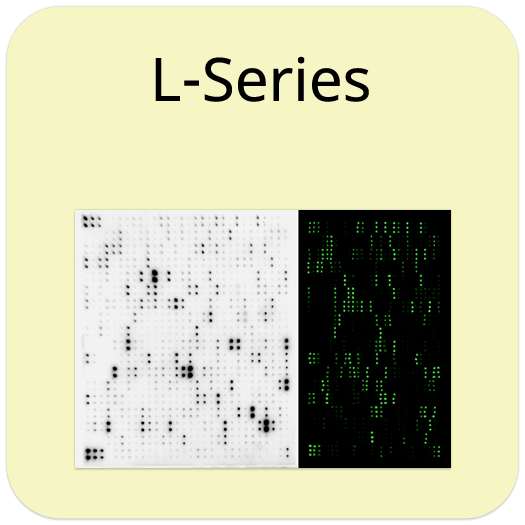Product Features
- High density arrays
- Unbiased detection through direct biotin labeling of samples
- Low sample consumption
- High detection sensitivity
- Same day result
- Affordable and simple to use
Target Names
15-PGDH (HPGD), 5T4, ABP1, ACP6, ACYP1, ADA, ADAM-12, ADAM23, ADAM28, AGR3, AIF1L, AK1, AKR1C1, AKR1C4, Alpha-Galactosidase A (GLA), Alpha-internexin, AmiGO2, Aminopeptidase O, Aminopeptidase P2 (XPNPEP2), AMSH (STAMBP), Arginase 1, ARNT (HIF-1 beta), Arylsulfatase A (ARSA), ASAH2 (Neutral Ceramidase), ASAHL, ASB17, ASF1B, B7-H4, BAI3, BAMBI (NMA), BCCIP, Bcl-2, BCL2L10, BCS1L, beta-Glucuronidase (GUSB), Beta-synuclein, BMP-8, BOC (Brother of CDO), BTN3A1, C1qTNF4, C1qTNF5, C1R, CA12, CA5B, CA6, CA8, Cadherin-11, Cadherin-15, Cadherin-17, Cadherin-4, Calnexin, Calreticulin-2, Calsyntenin-2, CANT1 (SCAN-1), Carbonic Anhydrase IV (CA4), Carbonic Anhydrase XIV (CA14), Carboxylesterase 2, Carboxypeptidase B1, Caspase-1, Caspase-2, Caspase-9, Caspr2, Cathepsin E, Cathepsin V (Cathepsin L2), Caveolin-2, Caytaxin, CD147 (EMMPRIN), CD164, CD2, CD200 R1, CD205, CD27 Ligand (TNFSF7), CD28, CD300a (LMIR1), CD34, CD39L2 (ENTPD6), CD39L3 (ENTPD3), CD4, CD5, CD58 (LFA-3), CD6, CD7, CD79B, CD86 (B7-2), CD99, CD99-L2, CDC14B, CDC25B, CDCP1, CDO, CDX4, CEACAM-3 (CD66d), CEACAM6, CEACAM7, Cerebellin-2, CES3, CHAT, CHI3L2, CHMP2B, CHST1 (GST-1), CHST15, CHST2, CHST3, CHST4 (GST-3), cIAP-1 (BIRC2/hIAP-2), CIB1 (CIBP), CILP-1, CITED2, CMG-2 (ANTXR2), Cofilin-2, COL2A1, COMT, Contactin-5, CRELD2, CRISP-2, CRISP-3, CRK, Cryptic, CSNK2A1, CTRC (Chymotrypsin-C/Caldecrin), C-type Natriuretic Peptide (CNP), CXADR, CXCL17 (VCC-1), CXXC1, Cyclin E1, CYFIP2, CYP4F11, CYP4F12, Cytochrome P450 2W1, Cytochrome P450 4B1, Cytohesin-2, Cytohesin-3, DAB2 (DOC-2), DAPK3, DAPP1, DAZL, DCSIGNR, DDR1, DDX21, Dectin-1 (CLEC7A), Desmoglein-3, Desmoglein-4, DFF45 (ICAD), DLEC (CLEC4C/BDCA-2), DNAM-1 (CD226), DNASE1, DNMT3A, DPPII (QPP/DPP7), DRAK1, Drebrin, DSCAM-L1 (DSCAM2), DUSP3, Dynactin subunit 1 (DCTN1), Dynactin subunit 2, Dynactin subunit 4, Dynactin subunit 5, DYRK3, Dystrophin, EDEM2, EDIL3, EDNRB, EGR1, EMR2, Endoglycan (PODXL2), eNOS (NOS3), ENPP5, ENPP-7 (Alk-Smase), Enteropeptidase, ENTPD1, ENTPD2, Ephrin-A4, Ephrin-A5, Epimorphin (Syntaxin 2), ESR2, Ets-1, Exostosin-like 3 (EXTL3), FABP6, FABP7, FABP8 (M-FABP), FAM3A, FAM3D, Fc epsilon RI, Fc gamma RI, FCAR (CD89), FES, FGF-3, Fgr, FHL1, Fibromodulin, Ficolin-1, FKBP4, Flotillin-2, FLRT1, FLRT2, FLRT3, FOLH1 (PSMA), Follistatin-like 4, FosB (G0S3), FOXC2, FOXJ1, FoxM1 (FKHL16), F-Spondin (SPON1), Fucosyltransferase 3, Fucosyltransferase 8, FUT11, FUT7, FXR (Bile Acid Receptor), GAD1, Galectin-4, Galectin-8, Galectin-9, GALNT10, GALNT3, Gastric Intrinsic Factor, GATA1, GATA2, GATA-5, GBA3, GLB1 (Beta-galactosidase), GLI-3, GLRX3, Glucokinase (GCK), Glycophorin-A, Glypican 1, Glypican 2, Glypican-4, GNMT, GPA33, Granzyme B, GRAP2, GRIA2, GRID2, GRK1, GRK5, GRM4, GRM7, HAND1, HAPLN1, HAPLN4, HCN4, Hepsin, Hexokinase-1, HIF-1 alpha, HIN-1 (SCGB3A1), HNF4A, HPGDS, HS3ST1, HS3ST3B1, HS3ST4, HSPH1, ICK, ICOS, Iduronate 2-Sulfatase (IDS), IGSF11, IGSF3, IGSF4C, IKK-gamma (NEMO/FIP-3), IL-28 R alpha (IFN-lambda R1), ILT-2 (LIR-1/CD85j), ILT-4 (LIR-2/CD85d), ING1, Inhibin alpha chain, Integrin alpha 1 (CD49a), Integrin alpha 5, Integrin alpha-11, Integrin alpha-3, Integrin alpha-4 (CD49d), Integrin beta-4, Integrin beta-7, Integrin alpha 2 (CD49b), Interferon epsilon, IPP2, IRF1, IRF-2, IRF-4, Islet-1, Jagged 1, Jagged 2, JAM-B (VE-JAM/CD322), JAM-C (CD323), JUN, JunB, Kallikrein 1, Kallikrein 12, Kallikrein-15, KIRREL3 (NEPH2), KPNA2, KRT12, KRT2, L1CAM (NCAM-L1), Latexin, Leukosialin, LILRA2, LILRB4 (CD85k/ILT-3), LOXL2, LRP chaperone MESD, LRRC32 (GARP), LRRC4, LRRC8D, LRRTM1, MAP1D, Matrilin-2, Matrilin-3, MD-1 (LY86), MD-2 (LY96), MDGA1, MDGA2 (MAMDC1), MDM2, MEF2C, Melan-A (MART-1), Meprin beta (MEP1B), METTL11A (NRMT), mGluR3, MIA, MIS RII (AMHR2), MKK7, MOG, MSP Receptor (Ron), MyD88, NAGA, NAPSA, NCK1, Nectin-2 (CD112), Nectin-4, NEDD9, Neudesin, Neurexin-3 beta (NRXN3), Neurofascin, Neurogenin-3, Neuroligin 2, Neuroligin-1 (NLGN1), Neuroplastin, NFATC3, NFKB1, NG2 (MCSP), NGL-1, NgR3 (NgRH2), Nicastrin, NKp30, NKp44, NKp46 (NCR1), NLGN4X, NLRP2, NMNAT-1, Nogo Receptor (Reticulon-4 Receptor), Norrin, Notch-3, NPDC-1, NQO-1, NTH1, NUDT5, Numb, NUP85 (FROUNT), Olig2, Oligo1, p63 (TP73L/KET), PAR1, Pax3, Pax-4, Paxillin, PCK1 (PEPCK-C), PGLYRP4, PILR-alpha, Pirin, PLA2G2A, PLA2G4A, Plexin-A2, PNPLA2, POGLUT1, PPA1, PRKCA, PRKN, Protein Wnt-9a, Protocadherin-1, Protogenin, PSMB8, PTGES2, PTGIS, PTH1R, PTP1B, PTPN11, RAB5A, RalA, RalB, RCOR1 (CoREST), Relaxin-1, Renalase, Renin, RGM-A, RGM-B, RGM-C (Hemojuvelin), RNF113A, RNF31, RNF43, ROBO2, ROBO3, R-Spondin 3, R-Spondin-2, S100 A13, S100 A2, SARS2, SBDS, Secretagogin, Semaphorin 3C, Semaphorin 4C, Semaphorin 4D, Semaphorin 4G, Semaphorin 5A, Semaphorin 6D, Semaphorin-3E, Semaphorin-4A, SERINC3, Serpin B2 (PAI-2), SH2B1, SH2D1A, Siglec-10, Siglec-11, Siglec-6, SIRP-gamma (CD172g), Sirtuin 1, Sirtuin 3, Sirtuin 2, Sirtuin 5, SLAM (CD150), SLC15A1, SLITRK2, SLITRK4, SLITRK5, SMAD2, SMAD3, SMOC-2, SMPD1, SMPD3, SNAP25, SorCS1, SorCS2, SorCS3, Sortilin, SOX10, SOX15, SOX21, SOX9, SPHK1, SPI1, SPRY1, SREC-I (SCARF1), SRGN, ST3GAL1, ST8SIA1, ST8SIA2, Stabilin-2, Stanniocalcin 1, STUB1, SULT1B1, SULT1C2, SULT2A1, SULT2B1, SULT4A1, SUMF1, SUMF2, SUMO1, SUMO2, Syntaxin 4, Syntaxin 6, TAZ (WWTR1), TBX18, TCF7L1, TC-PTP, TDP-43, Tenascin R, Testican 1 (SPOCK1), TFPI-2, THSD1, TINAGL1, TPH1, TPST2, TRACP (PAP/ACP5), TRAF-3 Isoform 2, Transcobalamin II, Transglutaminase 7, Transglutaminase 2 (TGM2), Transglutaminase 4 (TGM4), TREM-2, TrkA, TRP14 (Thioredoxin-like 5), TTK, UCH-L3, UGT1A1, ULBP-3, ULBP-4 (RAET1E), USE1, VAMP-1, VAMP-2, VAP-B, VDAC2, VIAAT, VISTA (B7-H5/PD-1H), Wnt-4, WTAP, WWP2
Application Notes
Suggested Application
Multiplexed Protein Detection; Detection of Relative Protein Expression; Detecting Patterns of Cytokine Expression; Biomarker Screening; Identifying Key Factors; Confirming a Biological Process; Cross-species testing
Kit Components
- RayBio® L-Series Antibody Array Glass Slide(s)
- Spin Columns
- Labeling Reagent
- Stop Solution
- Blocking Buffer
- Wash Buffer 1
- Wash Buffer 2
- Streptavidin-Conjugated Fluor
- Adhesive Plastic Strips
- Labeling Buffer
- Lysis Buffer
- 30 ml Centrifuge Tube
Other Materials Required
- Distilled or de-ionized water
- Small plastic or glass containers
- Orbital shaker or oscillating rocker
- 1 ml tube
- Pipettors, pipette tips and other common lab consumables
- Aluminum foil
- Gene microarray scanner or similar laser fluorescence scanner
View Compatible Laser Scanners
Don't have a compatible scanner? RayBiotech now offers FREE scanning service for all RayBio glass slide antibody arrays! Learn More
Protocol Outline
- Purify Samples with Spin Column
- Biotinylate Samples
- Purify biotinylated samples using spin column
- Dry the glass slide
- Block array surface
- Incubate with Samples
- Incubate with Streptavidin-Conjugated Fluor
- Disassemble the glass slide
- Scan with a gene microarray laser scanner
- Perform densitometry and analysis
Storage/Stability
For best results, store the entire kit frozen at -20°C upon arrival. Stored frozen, the kit will be stable for at least 6 months which is the duration of the product warranty period. Once thawed, store array slide(s) at -20°C and all other reagents undiluted at 4°C for no more than 3 months.


